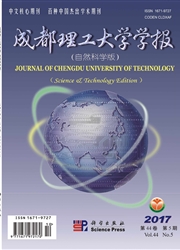

 中文摘要:
中文摘要:
泥石流山洪输沙比是工程防治设计的重要参数。本文以金沙江支流海子沟为例,调访了近115a的泥石流活动历史,查明了1996年一次最大规模泥石流运动参数,采用雨洪法计算了不同的泥石流发生频率下泥石流的流量、总量。通过对1899年至今海子沟堰塞坝泥沙淤积的测定,得出海子沟流域每年泥沙淤积量为1.23×10^5 m^3,总输沙量为1.42×10^7 m^3,流域平均剥蚀速率为1.5mm/a。由不同泥石流频率下海子沟泥石流的固体物质总量,计算出自1963年以来海子沟泥石流输沙量为1.67×10^6 m^3,而此期间山洪泥石流的总输沙量为6.65×10^6 m^3,由此确定海子沟泥石流的输沙量占山洪泥石流输沙总量的25%。而官坝河泥石流、白龙江流域泥石流、蒋家沟泥石流输沙量分别占总输沙量的29.5%、62.9%、99%,泥石流输沙量随着泥石流频率的增加而增加。高频率泥石流工程拦挡仅考虑泥石流输沙量;类似白龙江流域松散固体物质丰富的半干旱气候区泥石流防治拦挡工程需考虑山洪输沙量;而类似官坝河、海子沟中等频率的泥石流沟,需更多考虑山洪输沙量。
 英文摘要:
英文摘要:
Sediment transport ratio is an important parameter for control and design of debris flow engineering.The debris flow occurrence and magnitude of past 115 years for Haizi Valley and the largest debris flow triggered in 1996 are investigated and used to calculate the discharge and sedimentvolume of debris flow at different frequencies in Haizi Valley.The study and measurement of barrier dam siltation reveals that the annual sedimentation rate of Haizi Valley is 1.23×10^5 m^3,the total sediment volume is 1.42×10^7 m^3 and the average erosion rate in this area is 1.5mm/a.The debris flow sediment volume of Haizi Valley has been 1.67×10^6 m^3 since 1963 by using debris flow materials at different frequencies,while total sediment volume of flood and debris flows is 6.65×10^6 m^3 during this time.Therefore,the sediment transport ratio of 25%is obtained by dividing the sediment volume of debris flows by total sediment volume of flood and debris flows.It shows that the sediment transport ratio increases with rising frequency of debris flows,evidenced by 29.5% sediment transport ratio in Guanba River,62.9% in Bailong River Basin and 99% in Jiangjia Valley.Therefore,the control engineering in high frequency debris flow area only need to consider the amount of sediment,while the amount of flood sediment discharge should be considered in semi-arid climate zone with rich solid material like Bailong River.Much consideration should be given to the amount of flood sediment discharge in the debris flow areas,such as Guanba River and Haizi Valley.
 同期刊论文项目
同期刊论文项目
 同项目期刊论文
同项目期刊论文
 期刊信息
期刊信息
